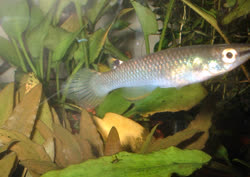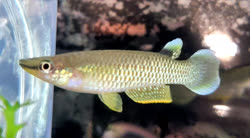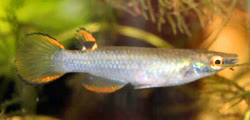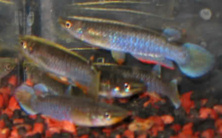|
|
Aplocheilus panchax
Recent DNA evidence, karyotpy and meristics of the scales of the head have shown there are four distinct groups within Aplocheilus panchax and the original PAN only refers to the fish the the Bengal basin, and the Ganges in India as well as Eastern Bangladesh. All the otherforms belong to A. armatus Except the population from the Andamans Islands which are A. andamandicus. See the discussion for AMT.
"A. panchax, the species under present study, was reported to have
n=18 and 2n=36 chromosomes by the same author (SCHEEL 1966, 1972)
in the Thailand population while the present findings in the India population
of the same species differed in having n = 19 and 2n = 38 chromosomes." [1978 Khuda-Bukhsh]
"Purpose of this experiment was to study on distribution and cytogenetics study of Aplocheilus panchax. Ten specimens of A. panchax 2.5-3.5 mm in SL, were used. An observation of mitotic metaphase chromosome prepared from gill, intestine and kidney tissue by the Uwa and Ojima's method (1981) were made. Levan et al.,'s method of chromosome classification was employed. The findings were as follows: 1) Apocheilus (sic) panchax were widely distributed in the Mae Nam Choa Phraya Basin. 2) The diploid chromosome number of A. panchax was 40. The Karyotype consisted of 4 paires of metacentric, 2 pairs of submetacentric, and 14 pairs of acrocentric chromosomes. The arm number was 52. These results will be useful for cytotaxonmy of fishes." [1992 Magtoon] Magtoon 1992 Distribution and cytogenetics of killifish, aplocheilus panchax (Hamilton-Buchman) from the central, Thailand [1992] Wichian Magtoon http://agris.fao.org/agris-search/search.do?recordID=TH2002000408 Khuda-Bukhsh 1978 Chromosomes in three species of fishes, Aplocheilus panchax (Cyprinodontidae), Lates calcerifer (Percidae) and Gadusia chapra (Clupeidae). http://sci-hub.io/10.1080/00087114.1979.10796783
|







































